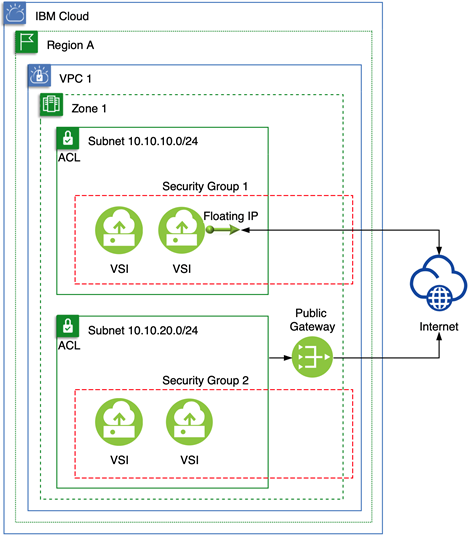HPC on Cloud Overview
High Performance Computing (HPC) in the IBM Cloud can accelerate results by scaling a vast number of tasks and reduce costs by optimizing the right technology to meet your specifc goals. The cloud is always ready whenever you are ready to scale up. Whether you need a single CPU core or tens of thousands cores, a traditional MPI-oriented cluster or fully containerized Openshift cluster, IBM Cloud has the solution to meet the needs.
For traditional MPI-centric HPC workloads, the most natural way to utilize cloud resources is the Virtual Private Cloud (VPC). Essentially, it provides a set of configurable resources for building a secure cluster on a public cloud. In its most essential form, a virtual private cloud consists of a number of virtual machine instances, connected through a software-define network which is isolated from other VPCs on the same public cloud. VPCs are a “best of both worlds” approach to cloud computing. They give customers many of the advantages of private clouds, while leveraging public cloud resources and savings.
| Component | Traditional HPC cluster | VPC cluster |
|---|---|---|
| Unit of compute node | A bare-metal node, fixed configuration | A virtual machine instance (VSI), flexible |
| Interconnect | Physical Ethernet, Infiniband, etc. | Software defined network |
On this website we focus exclusively on IBM Cloud Gen2 VPC. In such context, a “VPC” resource actually refers to the software-defined network at a specific datacenter. Unless otherwise indicated, the term “VPC” in this website always referred to this narrow definition. Each VPC consists of one or multiple subnets, each of which is mapped to a zone within that datacenter. Once the VPC is established, VSIs can be created within subnets. Such process is the cloud analog to installing a physical cluster - putting physical computer nodes inside a server room and connect them with networks so that they can be accessed from outside.

Region
A region is an abstraction that is related to the geographic area in which a VPC is deployed. VPC can span multiple zones in a region. Example: us-south
Zone
A zone is an abstraction that refers to the physical data center that hosts the compute, network, and storage resources, as well as the related cooling and power, which provides services and applications. Zones are isolated from each other. Example: us-south-1/2/3
Security Groups (SG)
Set of rules to filter traffic to an instance.
Subnet
Each subnet consists of a specified IP address range (CIDR block). Subnets are bound to a single zone and cannot span multiple zones or regions. Subnets within the VPC offer private connectivity; they can talk to each other over a private link through the implicit router. Setting up routes is not necessary.
Public Gateway
A Public Gateway enables a subnet and all its attached virtual server instances to connect to the internet.
Floating IP
Floating IP addresses are IP addresses that are provided by the system and are reachable from the public internet.
Virtual Server Instance (VSI)
A VSI is basically a virtual machine instance, created from a shared VSI profile (template, or base image) provided by the cloud. An VSI have multiple states (running, stopped, etc.) during its life cycle.
While it is possible to manually build a cluster from these componenets, there is a much easier way to deploy a HPC-oriented cluster on IBM Cloud. In fact, Most of the tutorials on this website are based on the automation package for Spectrum LSF. IBM Spectrum LSF is widely used to manage parallel distributed HPC workloads. The automation package deploys LSF management and compute hosts with a shared filesystem. It also configures auto-scaling of compute hosts with its resource connector for IBM Cloud. The deployed cluster runs the Red Hat Enterprise Linux 7.7 with pre-installed software packages such as OpenMPI.
The automation package enables users to quickly create an HPC cluster on IBM Cloud. Users can import data to the shared filesystem and submit HPC jobs using the bsub command. The automation can be regarded as a quick starter kit for HPC in the cloud, but also it enables cloud bursting, a technique to deal with the temporal insufficiency of computing resources at an on-premise cluster using the elastic cloud infrastructures.